Cleistocactus
Cleistocactus is a genus of flowering plants in the cactus family Cactaceae, native to mountainous areas - to 3,000 m (9,843 ft)[1] - of South America (Peru, Uruguay, Bolivia and Argentina). The name comes from the Greek kleistos meaning closed because the flowers hardly open.
| Cleistocactus | |
|---|---|
 | |
| Cleistocactus strausii | |
| Scientific classification | |
| Kingdom: | Plantae |
| Clade: | Tracheophytes |
| Clade: | Angiosperms |
| Clade: | Eudicots |
| Order: | Caryophyllales |
| Family: | Cactaceae |
| Subfamily: | Cactoideae |
| Tribe: | Cereeae |
| Subtribe: | Trichocereinae |
| Genus: | Cleistocactus Lem. |
| Type species | |
| Cleistocactus baumannii | |
| Species | |
|
See text | |
Description
The plants of the genus are slender stem succulents that are tall, mostly slender and often many-branched up to about 3 m high. They usually form basally branching shrubs, rarely they branch higher and form small trees. The shoots stand upright and then often hang over as they get older; they usually lie down with their ends rising up; more rarely they grow hanging. They usually have many ribs, closely set areoles and spines. The areoles on the ribs usually have many fine, hair-like spines with a few firmer spines in between; the spines are rarely longer and coarse.
In most species, the flowers appear in large numbers individually from the areoles. The flowers are tubular and the tips hardly open with only the style and stamens usually protruding. In some species (from the earlier genera Borzicereus and Cephalocleistocactus) they appear from conspicuous zones of heavy bristle and hair formation. In adaptation to the pollinators (hummingbirds), the flowers are long, tubular with upright bracts, which are sometimes not or only slightly folded outwards at the tips and thus appear almost closed. They are often slightly zygomorphic due to an upward bend near the base and/or an oblique flower border (longer or straighter at the top, shorter or more folded at the bottom). The flower colors range from green to white, yellow, orange and red to violet, with shades of red predominating. The densely scaled fruits that emerge after fertilization are relatively small, but usually contain numerous seeds.
Species
Species of the genus Cleistocactus according to Plants of the World Online As of July 2023:[2]
| Image | Scientific name | Distribution |
|---|---|---|
| Cleistocactus ayopayanus Cárdenas | Bolivia | |
.jpg.webp) | Cleistocactus baumannii (Lem.) Lem. | Argentina, Paraguay, Bolivia, Uruguay |
 | Cleistocactus brookeae Cárdenas | Bolivia |
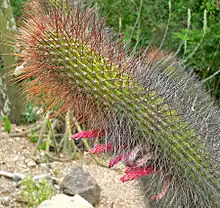 | Cleistocactus buchtienii Backeb. | Bolivia |
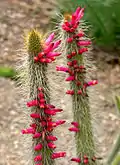 | Cleistocactus candelilla Cárdenas | Bolivia |
| Cleistocactus capadalensis F.Ritter | Bolivia (Chuquisaca) | |
| Cleistocactus chrysocephalus (F.Ritter) Mottram | Bolivia | |
| Cleistocactus dependens Cárdenas | Bolivia | |
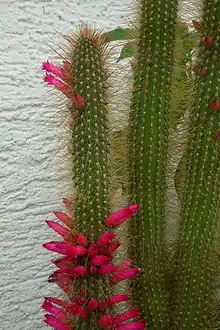 | Cleistocactus hildegardiae F.Ritter | Bolivia |
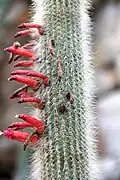 | Cleistocactus hyalacanthus (K.Schum.) Rol.-Goss. | Argentina, Bolivia |
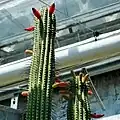 | Cleistocactus laniceps (K.Schum.) Rol.-Goss. | Bolivia |
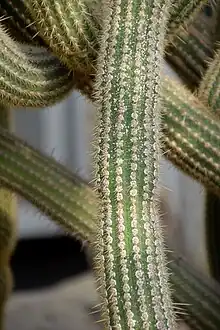 | Cleistocactus luribayensis Cárdenas | Bolivia |
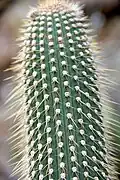 | Cleistocactus micropetalus F.Ritter | Bolivia |
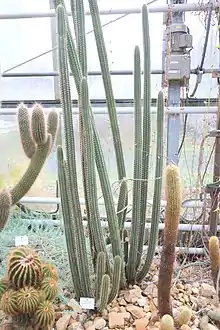 | Cleistocactus morawetzianus Backeb. | Peru |
 | Cleistocactus parviflorus (K.Schum.) Rol.-Goss. | Bolivia |
 | Cleistocactus pungens F.Ritter | Peru |
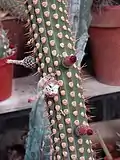 | Cleistocactus reae Cárdenas | Bolivia |
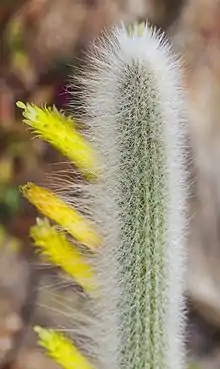 | Cleistocactus ritteri Backeb. | Bolivia |
 | Cleistocactus samaipatanus (Cárdenas) D.R.Hunt | Bolivia |
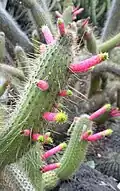 | Cleistocactus smaragdiflorus (F.A.C.Weber) Britton & Rose | Argentina |
.jpg.webp) | Cleistocactus strausii (Heese) Backeb. | Bolivia, Argentina |
 | Cleistocactus tominensis (Weing.) Backeb. | Bolivia |
| Cleistocactus variispinus F.Ritter | Bolivia | |
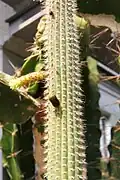 | Cleistocactus viridiflorus Backeb. | Bolivia (La Paz) |
.jpg.webp) | Cleistocactus winteri D.R.Hunt | Bolivia |
Synonyms
The following genera have been brought into synonymy with this genus:
- Akersia Buining
- Bolivicereus Cárdenas
- Borzicactella H.Johnson ex F.Ritter
- Borzicereus Fric & Kreuz. (orth. var.)
- Cephalocleistocactus F.Ritter
- Cleistocereus Fric & Kreuz. (orth. var.)
- Clistanthocereus Backeb.
- Demnosa Fric
- Gymnanthocereus Backeb.
- Hildewintera F.Ritter
- Maritimocereus Akers
- Pseudoechinocereus Buining (nom. inval.)
- Seticereus Backeb.
- Seticleistocactus Backeb.
- Winteria F.Ritter
- Winterocereus Backeb.
References
- RHS A-Z encyclopedia of garden plants. United Kingdom: Dorling Kindersley. 2008. p. 1136. ISBN 1405332964.
- "Cleistocactus Lem". Plants of the World Online. 2021-06-13. Retrieved 2023-08-01.
- Innes C, Wall B (1995). Cacti, Succulents and Bromaliads. Cassell & The Royal Horticultural Society.
- The species list is referenced from http://www.cactiguide.com/ which is in turn referenced from several books which are listed on that site. The principal book listed here is The Cactus Family by Edward F. Anderson.
External links
- (in French) photos on www.AIAPS.org
- (in English) photos on www.cactiguide.com

